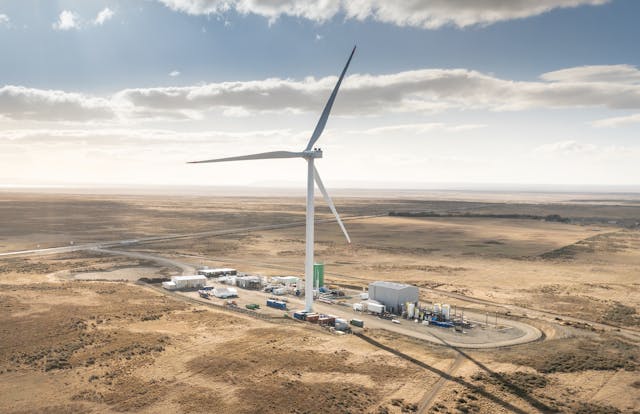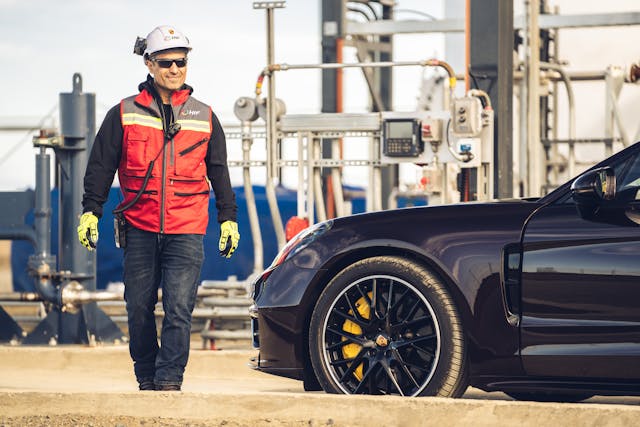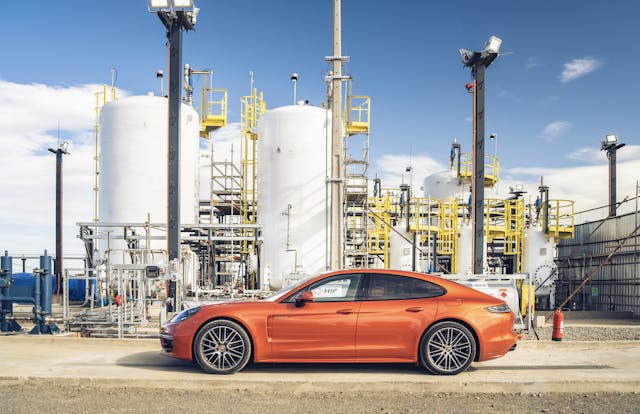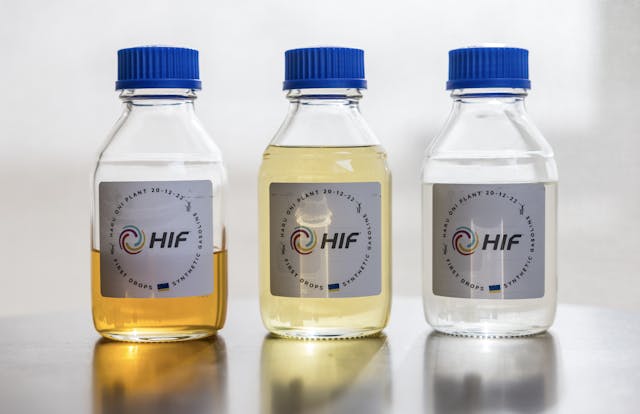Can e-fuels save classic cars?
You’ve probably seen the headlines. Ours, even. Stuff like, “Porsche Creates Magic Gasoline From Wind and Water—Saves Both Internal Combustion and The World.”
It sounds promising but also a bit fantastical, like something out of a supermarket tabloid. So, out of curiosity and a bit of skepticism, we recently went with Porsche to Chile to learn how the stuff is made, what it does, and what it won’t do.
E-fuel sounds exciting but, um … what is it?
In an e-nutshell, it’s a synthetic fuel that is carbon neutral, meaning it’s developed with CO2 that has already been released into the atmosphere using renewable energy. In this case, the renewable is wind. There’s a lot of it here in Chile’s Magallanes Region. As our plane bucked and shuddered with turbulence on its descent, I gazed out at an endless array of whitecaps breaking in the ceaseless gale. On the ground, the wind is both strong and seemingly inexorable, shaping most of the larger flora as they grow into swept and crooked exaggerations.

“It’s not that there’s so much wind, but that it’s so predictable and reliable,” said Marcelo Daller. He manages the facility we’ve come all this way to see, a small plant operated by Highly Innovative Fuels (HIF) Global, which handles the nitty gritty development on this project. Daller’s narration is subtly chopped by the whistling woosh of the facility’s lone wind turbine. He told me there’s no need to build it high, so the blade tips spin just 60 feet from the ground; I caught myself almost ducking as we passed by. HIF estimates 6,000 hours of high-quality wind in the region each year, equating to 70 percent uptime for the turbines.
Those turbines power the entire process, the first step of which is a carbon-dioxide recapture system from Global Thermostats. Think of it as a very, very large air purifier. Fans cycle air through a ceramic honeycomb matrix that—through a variety of processes we’ll just call “chemistry”—separate the CO2 from other molecules. When the final system goes online, HIF expects to scrub 150 kg of CO2 an hour. (At the time of our visit, the system was not yet operational, so for now, the plant sources its renewable “green” carbon dioxide from a brewery.)
At the other end of the facility, 35 percent of the power from that spooky wind turbine is routed to a Siemens electrolyzer that produces 21 kg of green hydrogen per hour through electrolysis. Said hydrogen and CO2 is run through a copper-zinc catalyst to form synthetic methanol that serves as the basis for all the plant’s carbon-neutral hydrocarbon derivatives.

Methanol—familiar to any drag racer—is then put through ExxonMobil’s proprietary methanol-to-gas (MTG) process to transform the alcohol into gasoline. Or kerosene, or diesel. In fact, HIF claims the process can crank the hydrocarbon chains as high as “C12” and crack them as low as “C5,” for the petrochemical nerds in the audience.
Burning the resulting fuel will still release carbon into the atmosphere, just as with conventional fuels. But whereas the carbon in fossil fuels is “new,” having previously been locked in a hydrocarbon molecule underground, that in e-fuels is recycled, having been pulled from the atmosphere.
Wow, that sounds high-tech.
It really isn’t. We’re basically talking about electrolysis, which was first observed in water in 1789. There have been efforts to make synthetic fuels for many decades. Germany, for instance, figured out how to make aviation fuel from coal during World War II. Not even ExxonMobil’s proprietary methanol-to-gas procedure is new. “That is a mature and venerable technology dating back to the 1970s, an outcome of the OPEC oil embargoes and fuel supply pressures,” explained André Boehman, a mechanical engineering professor at the University of Michigan and a leading expert in e-fuels.

“The concept of a drop-in fuel has been around for decades,” agreed John Voelcker, a journalist who, as the founding editor-in-chief of Green Car Reports, has long focused on the green car space. “If you talk to fleet managers—the old and grizzled ones—they will tell you about the ‘Alt Fuel of the Year Problem.’ Because in my lifetime, we have seen ideas involving ethanol, methanol, natural gas, ethanol again in its E85 form, and now ethanol blended in the feedstock at E10, with E15 on its way, and so on.”
Carbon capture is far newer, but still considered old-hat by modern standards. The concept was first posed in 1938, and a large-scale carbon recapture project launched in 1972, according to Columbia University, when the Sharon Ridge oilfield in Texas injected CO2 into the ground. The technology remained somewhat stagnant through the mid-1990s, until Norway’s Sleipner program went live in the North Sea as the first integrated carbon capture and storage project.
The biggest hurdles for alt-fuels of all varieties have been economic rather than technological: conventional fossil fuels are really profitable, alternative fuels are clearly less so. Lacking a business case or regulatory requirements meant there was no reason to pursue them at large scale. “Many alt-fuels come about from a regulatory push,” explained Voelcker. “It’s fairly rare that there is a demand-pull for alt-fuels from actual consumers.”

Concerns about global warming and widespread pressure to reduce use of fossil fuels obviously changes the calculus, which helps explain why Porsche thought the project was worth an investment of $100M (and growing). Like every major automaker, Porsche has lots of electric vehicles in the pipeline—at least 50 percent of its lineup will be battery EVs or plug-in hybrids by 2025, and it’s aiming for that to grow to 80 percent by 2030. But that still leaves a certain number of dino-burners, which I’m willing to speculate hail from the 911 family, and there might simply be too much brand identity and equity on the line to ditch the gas-powered ass-engines entirely.
What would I need to do to my car to use it?
That’s the beautiful part: Nothing. This e-fuel is a true drop-in replacement, provided the mix is correct.
“Most fuels are not specific molecules and more of a mixture of chemicals that fit a certain specification,” explained Stephen McCord, a research fellow at the University of Michigan’s Global CO2 Initiative. In other words, with the right mixture of molecules and proper era-appropriate additives, e-fuels could run anything from an airliner to a Model T to a 917K or a GT3 RS.

Porsche let the assembled journalists pour around 12 gallons of this novel fuel into Panameras, then sent us on our way. Porsche swears it levied no changes unto the Panamera’s ECU or fuel system. I immediately noticed…no differences at all. Not once during our roughly 250-mile tour of Patagonia did the Panamera drop power, cut out, stutter, cough, sniff, or sneeze. My driving partner and I broke conversation every hour or so to remind each other we’re driving on a tank filled with wind and water. “Notice anything? No? Alright. Oh hey! An emu!”
This all sounds fantastic. Where can I buy some?
You can’t, and for the foreseeable future you won’t be able to in any real sense. The demo plant’s current production is capped at around 90 gallons a day, most of which is earmarked for use in Porsche’s Supercup racing series and a rotating fleet of internal test vehicles ranging from a 993 to a 991.2.
A large, full-scale production facility is planned roughly 20 miles south, with 60 windmills providing enough energy to produce 17.4 million gallons of e-fuel for use in South American and European markets. Facilities in Australia for Asian distribution and in Houston, Texas, for North America are also in the works. When all three are online and firing at full capacity, HIF expects a supply of 150,000 barrels of e-fuel a day. That sounds like a lot until you look at production figures for conventional oil—nearly 90 million barrels a day even during the pandemic-cramped years of 2020 and 2021. And even that limited supply won’t be offered directly for sale. Aside from the infinitesimal amount being produced at the Porsche-backed demonstration plant, every drop will be unceremoniously poured into the existing pool of consumer gasoline around the world to bring the general carbon footprint down.

The main limitation to scaling up is financial. Both Porsche and HIF were mum about the real cost of the e-fuel on the consumer side, but they readily admit it would need government subsidies to be competitive. “We can adjust tax politics to make e-fuels cheaper…politics should support investments to make prices more attractive,” Porsche CEO Oliver Blume recently told Reuters.
There are also technical and logistical hurdles. “Arguably the biggest challenge when it comes to scale-up (for all e-fuels, e-chemicals etc.) is hydrogen provision,” said McCord, the University of Michigan researcher. “Simply put, electrolyzers are relatively ‘small’ when compared to the volumes of fuel (therefore H2) we need.” He adds that hydrogen electrolysis is energy intensive; without an affordable renewable form of electricity, producing significant amounts of it for e-fuel would become prohibitively expensive.
Then there’s the fact that e-fuels already have major competition. Comparisons of e-fuel to electric vehicles are largely theoretical at this moment, since neither is close to the scale of fossil fuels, but electric vehicles do enjoy inherent advantages. In particular, using electrons to power vehicles directly is far more efficient than deploying those same electrons to convert CO2 into e-fuels. “Driving solely on e-fuels would require six times more electricity than using BEVs,” stated a 2021 white paper from the International Council on Clean Transportation. In practical terms, that means e-fuels will require vastly more land (and money) for windmills, solar panels, and other forms of renewable energy.

That said, e-fuels have important advantages of their own: They are easier to deliver, given that there’s already a vast network for gasoline, and they could render the billions of cars already on the road more environmentally friendly. Those vehicles, just like when they’re powered by conventional gasoline, would generally be able to travel further and refuel faster than today’s electric vehicles. And if e-fuels present issues at scale, so do EVs. McCord specifically pointed to their reliance on certain metals, like nickel and cobalt, although he noted there has been some progress in this area.
Of course, there’s also politics and perception: Many governments have already weighed in on this discussion with bans on ICE vehicles and incentives for EVs, and a growing segment of the general public sees them as an attractive solution. “The ideal alt-fuel would be one that has regulatory push and consumer pull, and we see that with EVs,” said Voelcker. “Large numbers of people like EVs, they like the idea of fueling at home, they like the idea of instant torque, etc.”
The politics aren’t set in stone—Germany, for instance, has recently lobbied for the European Union’s 2035 ban on the sale carbon-emitting vehicles to make allowances for ICE vehicles powered by e-fuels. Yet for automakers making bets now on where to put their R&D dollars, EVs clearly have an edge.

So, how excited should we be?
We’d still say, “very.” Given all the challenges, it seems unlikely (albeit not impossible) that e-fuels will become a dominant, mainstream source of power for personal transportation. Yet they still have huge promise. McCord noted that they could be a potential solution for sectors where there isn’t yet a viable fossil fuel alternative, such as aviation. And a number of full-size tanker ships can run on e-methanol, eliminating some of our naval reliance on bunker fuel—nasty, sulfurous stuff that has been found to be particularly harmful to people who live along shipping channels.
Most of the independent experts we spoke to describe the relationship between e-fuels, EVs, and other green energy sources not as zero-sum but collaborative—using each where it makes sense in the overall fight to reduce greenhouse gas emissions.
“My personal opinion is that we need all three—battery electric vehicles, biofuels [such as ethanol] and e-fuel to displace petroleum fully,” said Boehman, the University of Michigan engineering professor. “Dropping in things that look like today’s fuels and electrifying where that makes sense (passenger cars, short haul trucking), we can get there.”
Of course, we’re most excited for our old cars. At best, e-fuel might extend the lifeline of the production ICE. At worst, it will freeze it in amber. Taking a thousand-foot view of e-fuels blots out most of the downsides and uncertainty; since there is no noticeable difference in how a vehicle runs on this e-fuel, it means all ICE cars face meaningful and active preservation in an electric future.

***
Check out the Hagerty Media homepage so you don’t miss a single story, or better yet, bookmark it. To get our best stories delivered right to your inbox, subscribe to our newsletters.
Via Hagerty Insider



This is just an option for those who will be able to afford it.
The problem is it will not be cheap to make and demand will be limited due to prices.
The only real option is to keep oil based gas in production for the trucks and keep it available for collectors. Still not a cheap option.
Like attempts at gun control they have made ammo difficult to buy. They have made good gas and oil difficult to buy.
This won’t be an option that people will select at the pump any more than ethanol is today. It would be blended into the regular, mid-grade, or premium gasoline that people choose. Given what will be required to scale this, it will be a long time before we’ll see any “e-fuel blend” stickers at the pump (if ever).
I’ve read in other sources the current market price to be in the $10-12/gallon range, fully scaled up to the $6-7.
Diesel and gasoline can also be synthesized from human and animal bio wastes for a sightly lower cost. Since that too has a quicker carbon cycle, it is essentially net zero.
The article fuels are a great advancement in additives and blend packages to add to other syn fuels, especially to get to the magic 95-96 pump gas octane rating.
Because the energy density of liquid fuels is much greater than current battery tech, it presents a viable alternative.
I’m pretty sure that fuel – of any type – is going to get more expensive. That will obviously limit both the amount of driving that can be done by owners of classics and the number of people that can even own one. But what encourages me is that at least there are those out there that are searching for options rather than just throwing up their hands and resigning us all to a fate. Sure, there are going to be failures. Sure, things probably won’t ever be as good as “the good ol’ days”. Sure. But if history is any indication, mankind will keep looking for solutions; will keep innovating; will keep experimenting – and some day, the curve will change directions. I say BRAVO for those that are at least working on it!
It’s all about economics and this is a joke.
Hmmm…no, I think they were serious in the article.
I think it is an April fools day joke, published one week early.
http://www.carbonengineering.com Shorter distance to Squamish BC than to Chile I suspect!!
In the current war on petroleum being waged by politician-investors and the mainstream media, I’ve yet to read or hear about how their fantasies address plastics. Not only the raw materials, but the billions of tons of waste. The whole deal reeks of the old tale of the Emperor’s new clothes.
While I am happy this is something being pursued I also feel this is a lot of time money and energy to accomplish something we already have. This is really to appease the sky is falling crowd.
This is absolute nonsense!
You emit CO2 regardless of the origin of the fuel your car burns.
We may as well keep on burning oil pumped out of the ground and invest in carbon capture.
In the end there is no difference, as long as you balance the carbon dioxide going out with the carbon dioxide going back in.
I own four cars, but I try to either walk, or use the bike, as much as possible.
David is correct- the electrons that power an EV come from either a natural gas, oil or coal burning power plant- so we are not really taking the hydrocarbons out of the equation only moving the source of the CO2 being released to a stationary power plant (which admittedly has better changes of scrubbing that CO2) – best bet is still some type of hydrogen fuel cell (as used in space travel) which uses other renewables to get the process (water purification, electrolysis and super cooling) done- that’s why in fact Toyota never got into the EV market with both feet- only hybrids- until recently- they saw the future but pulled the trigger to soon.
Hydrogen fuel cells are impractical on earth.
The physical size of the containment vessel is prohibitive. Even with liquid Hydrogen, it is much larger and the gas itself permeates through many pressure vessels.
Space is ideal for solar gathering, so the limits there are panel size. But the energy needed to crack and then liquify Hydrogen is immense.
“70 percent uptime for turbines”. Even in this area of constant wind they cannot run fulltime. What would be the comparable natural gas fired plant? I would bet close to 100%.
That doesn’t make sense in this application. The point is to not add additional carbon into the atmosphere while attempting to make a fuel that…would be adding carbon into the atmosphere when it is burned. Windmills do not need a supply of carbon-based fuel to operate. The converse thinking is why operate a natural gas plant that requires the expense of a carbon resource when there’s wind flowing and that’s free? Free to harvest and free of carbon.
Because Tim, windmills are only good for a certain amount of power. The gas plant can supply 24 hours a day while the windmills only a portion of that time & only with sufficient wind. All sources of power should be utilized, not just the woke ones! This rush to EV everything is just stupid!
No one has discussed the personal tax implications for this “Fuel”… How much subsidy will be needed is anyone’s guess… As long as the Feds pour tons of money into the pot, who cares?… Debts of trillions of dollars should stall this project…
Once again, Private industry is now even solving problems that dont exist. You have to hand it to the engineers, THEY actually “do” something. Kudos!
The big deal about EVs will eventually subside and there is no reason to suddenly abandon producing fossil fuel for ICE caes. We are not even able to produce the electricity to charge them all should it be pushed on us. Are we supposed to abandon our air conditioning for EVs? All the hype for a climate awareness that has never become the disaster they predicted.
It has not become a disaster … yet. It will.
This “green fuels” discussion reminds me of a story about my grandfather. When my Dad and my Uncle wanted to take over the farm, Grandad wouldn’t let them buy a new (used) tractor because it had rubber tires. He insisted on steel wheels. In Grandad’s opinion rubber tires were too expensive and too unreliable (he drover a Model T first, then a 33 Fordor sedan and was always getting rubber tires repaired.) to be used on anything as tough on tires as a tractor.
Look at how wrong Grandad was! I wonder how wrong many of us are going to be regarding fuels of the future? My guess is “lots of us”!
Reading user feedback to many of Hagerty’s articles suggests there are many, many Grandads here! 😁
Rubber tires are for comfort, reduced NVH/wear, and the more simplistic and disposable Nature associated with them.
Steel wheels are still used in numerous environments when longevity is necessary.
If you could get this stuff in pure form it would make your car zero emissions. As for the CO2 that comes out when you burn this stuff, this fuel is made from CO2 from the air, so that becomes a push. The people complaining about what about plastic, well plastic is oil turned into a solid, not stuff in the air that will choke you. Honestly the complainers here must have forgotten the 60’s and 70’s when there was a smog cloud over every city in America most of the year. People are forgetting that most automotive innovation came from the government saying “you can’t do it that way any more”. Leaded fuel brought down IQ’s by at least 10 points because it was doing brain damage to people, I bet some people here think we should still have Lead in fuel.
Well, gasoline DID smell better when it had lead. ;<)
If we start harvesting massive amounts of energy from the factors that produce climate, namely sunshine and wind, then are we not asking for climate change? Just asking.
All of mankind since the industrial revolution had caused only a couple percent of the CO2, with Volcano Eruptions (both on earth and undersea) emits over 90%. If you can stop all volcano eruptions, I will buy this nonsense fuel. Until then, just the United States alone has over 530 years of known petroleum and that may be less than half of the actual petroleum available. No, I like my internal combustion engine with easy refueling stations already built and of course the products from plastic to manure that requires natural gas to create, and so you can drive yourself nuts with green dreams, but realistically over 700,000,000 people do not have clean drinking water, they count more. As it takes petroleum to drill, pump, run filtration stations and then to pump and distribute to people, all who need water more than green dreams, to actually survive!
Is there a source for your statements “only a couple percent of the CO2…,” “Volcano eruptions…” and “530 years of known petroleum…” ?
Bravo! The term “fossil fuel” was started to get the masses to believe petroleum is limited. Oil comes from well below the “fossil line”. The scale of cost to be “green” can’t even be calculated. You think goods are expensive now!